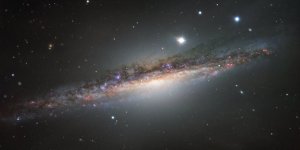| News / Space News |
The Strange Structures of the Saturn Nebula
The spectacular planetary nebula NGC 7009, or the Saturn Nebula, emerges from the darkness like a series of oddly-shaped bubbles, lit up in glorious pinks and blues. This colourful image was captured by the powerful MUSE instrument on ESO’s Very Large Telescope (VLT), as part of a study which mapped the dust inside a planetary nebula for the first time.

MUSE image of the Saturn Nebula. ![]()
The Saturn Nebula is located approximately 5000 light-years away in the constellation of Aquarius (The Water Bearer). Its name derives from its odd shape, which resembles everyone’s favourite ringed planet seen edge-on.
But in fact, planetary nebulae have nothing to do with planets. The Saturn Nebula was originally a low-mass star, which expanded into a red giant at the end of its life and began to shed its outer layers.
This material was blown out by strong stellar winds and energised by ultraviolet radiation from the hot stellar core left behind, creating a circumstellar nebula of dust and brightly-coloured hot gas. At the heart of the Saturn Nebula lies the doomed star, visible in this image, which is in the process of becoming a white dwarf.
The team used MUSE to produce the first detailed optical maps of the gas and dust distributed throughout a planetary nebula.
The resulting image of the Saturn Nebula reveals many intricate structures, including an elliptical inner shell, an outer shell, and a halo. It also shows two previously imaged streams extending from either end of the nebula’s long axis, ending in bright ansae (Latin for “handles”).
Intriguingly, the team also found a wave-like feature in the dust, which is not yet fully understood. Dust is distributed throughout the nebula, but there is a significant drop in the amount of dust at the rim of the inner shell, where it seems that it is being destroyed. There are several potential mechanisms for this destruction.
The inner shell is essentially an expanding shock wave, so it may be smashing into the dust grains and obliterating them, or producing an extra heating effect that evaporates the dust. (ESO)
YOU MAY ALSO LIKE

